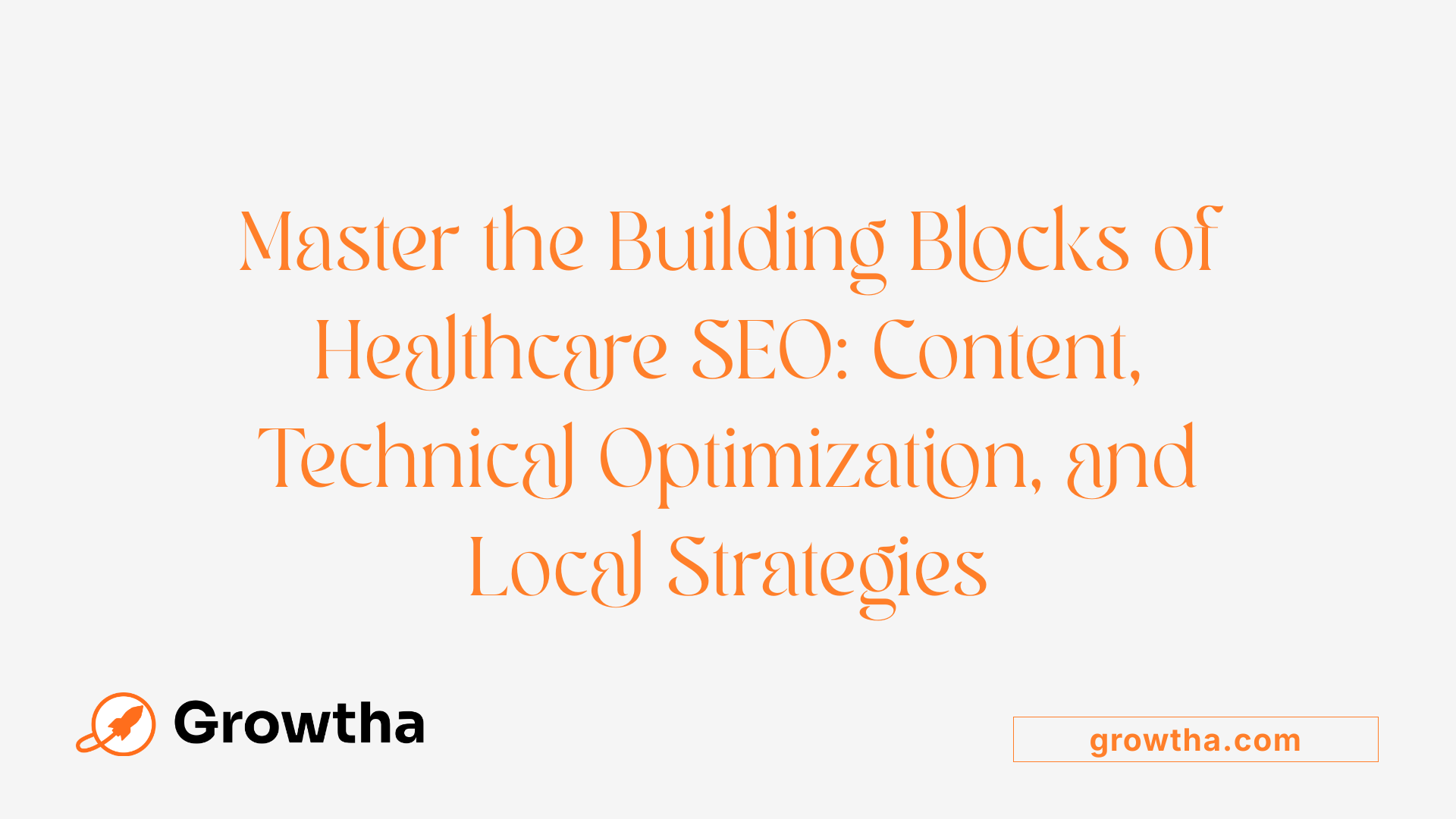SEO Best Practices for HCBS Providers
Maximizing Visibility in Home and Community-Based Services


SEO Best Practices for HCBS Providers
Unlocking the Power of SEO for HCBS Providers
In today’s digital landscape, healthcare providers, especially those offering Home and Community-Based Services (HCBS), must harness effective SEO strategies to stand out. With most healthcare-related searches being highly location-specific, optimizing for local search is critical to attracting nearby clients, caregivers, and partnering agencies. This guide explores essential SEO best practices tailored for HCBS providers, focusing on technical, content, and local strategies that boost online visibility, build trust, and ensure regulatory compliance.
Core Principles of Effective Healthcare SEO

What are the key principles of effective healthcare SEO, and how can they improve a website's search engine ranking?
Effective healthcare SEO relies on several fundamental strategies that collectively enhance a website’s visibility in search engines. Central to this is creating high-quality, authoritative content that clearly demonstrates expertise, authority, and trustworthiness—often summarized by the acronym EAT. This means producing accurate, comprehensive, and patient-centric information that search engines recognize as reliable.
Technical website optimizations are equally important. Ensuring fast site load times, mobile responsiveness, and the implementation of schema markup help search engines crawl and index healthcare websites efficiently. These technical factors not only improve rankings but also provide a seamless experience for users.
Local SEO plays a crucial role, especially for healthcare providers targeting nearby patients. Optimizing Google My Business profiles by keeping NAP (Name, Address, Phone Number) details accurate, managing patient reviews professionally, and building diverse citations across local directories can position a practice prominently in local search results.
Building reputable backlinks from authoritative healthcare websites and respected online directories boosts a website’s trustworthiness and domain authority, which are key ranking signals. Combining these efforts with ongoing content marketing—like blog posts, videos, and FAQs—helps attract and engage users.
Finally, regular use of analytics tools such as Google Analytics and Search Console allows providers to monitor performance, identify opportunities for improvement, and adapt strategies accordingly. When integrated, these principles help healthcare websites rank higher, attract more qualified patients, and establish credibility as trusted healthcare resources.
More Search Queries: Healthcare SEO best practices, EAT principles, technical healthcare website optimization, local SEO for healthcare providers
Fundamental Components of Healthcare SEO
 Healthcare providers aiming to improve their online visibility should focus on several core SEO aspects to attract and engage patients effectively.
Healthcare providers aiming to improve their online visibility should focus on several core SEO aspects to attract and engage patients effectively.
One of the most important elements is creating high-quality, authoritative, and patient-centric content. This involves developing blogs, FAQs, videos, and infographics that directly address patient concerns and are crafted or reviewed by qualified medical professionals to ensure accuracy and trustworthiness.
Optimizing on-page SEO components is equally vital. Providers must ensure that each webpage has well-structured title tags, meta descriptions, and headers that incorporate relevant keywords. Using schema markup (structured data) further enhances the ability of search engines to understand content, improving visibility in search results.
Technical SEO considerations include improving website speed, ensuring mobile-friendliness, implementing secure connections (HTTPS), and maintaining a clear site architecture. Creating a comprehensive sitemap and optimizing robots.txt files help search engines crawl and index the website efficiently. These technical practices provide not only better search rankings but also a positive user experience.
Off-site SEO strategies involve building backlinks from reputable healthcare websites, directories, and authoritative sources. These links boost domain authority and trustworthiness in the eyes of search engines. Managing online reputation by actively encouraging and responding to patient reviews enhances credibility and local search visibility.
Local SEO is crucial for healthcare practices seeking nearby patients. This includes optimizing Google My Business profiles with accurate NAP (Name, Address, Phone) details, uploading high-quality images, encouraging reviews, and utilizing local keywords within website content and citations.
To measure success and refine strategies, providers should continually monitor SEO metrics such as organic traffic, search rankings, user engagement, and conversions using tools like Google Analytics and Search Console. Staying aligned with Google’s standards—like EAT (Experience, Expertise, Authority, Trust)—and adhering to legal privacy requirements such as HIPAA is essential.
In summary, a comprehensive healthcare SEO approach combines authoritative content, on-page and technical optimization, reputable backlinking, and robust local strategies. Continuous evaluation and compliance ensure long-term success in attracting new patients and building trust.
Harnessing Local SEO for Greater Reach

How can local SEO techniques benefit healthcare providers and home care agencies?
Local SEO is essential for healthcare providers and home care agencies seeking to attract nearby patients. By focusing on location-specific strategies, these practices can improve their visibility in local search results, particularly in Google Maps packs and local listings.
One of the most effective methods is optimizing Google My Business (GMB) profiles. Ensuring that NAP (Name, Address, Phone number) details are accurate and consistent across all online platforms helps search engines trust the information, boosting rankings. Adding high-quality images and regularly updating the profile with relevant posts can make the listing more engaging.
Encouraging patients to leave reviews and responding professionally to feedback increases credibility and local search prominence. Positive reviews act as social proof, influencing potential patients.
In addition, creating location-specific webpages and content tailored to local communities enhances relevance. Incorporating localized keywords and schema markup helps search engines better understand and rank the content.
Building local citations—mentions of the practice's details on reputable directories and community sites—further strengthens domain authority. Using local keywords throughout website content, headings, and metadata improves search targeting.
Maintaining consistent contact information across all digital touchpoints and ensuring websites are mobile-friendly provide a seamless user experience, encouraging patients to reach out or book appointments effortlessly.
Ultimately, applying these local SEO techniques results in higher organic traffic, improved trust among community members, and increased inquiries, leading to better patient engagement and growth.
Keyword Research and Content Strategy for Healthcare SEO
 Effective healthcare SEO begins with thorough keyword research. Healthcare providers should utilize tools such as Google Keyword Planner, SEMrush, Ahrefs, and Moz to identify both broad and long-tail keywords that are relevant to their services and location. This research helps uncover what potential patients are searching for and how competitive those terms are.
Effective healthcare SEO begins with thorough keyword research. Healthcare providers should utilize tools such as Google Keyword Planner, SEMrush, Ahrefs, and Moz to identify both broad and long-tail keywords that are relevant to their services and location. This research helps uncover what potential patients are searching for and how competitive those terms are.
Focusing on health-specific and detailed search terms—like symptom-based queries or service-specific keywords—can significantly increase relevance and attract high-intent visitors. Incorporating these keywords naturally into authoritative and patient-centric content builds trust and adheres to Google’s standards like E-E-A-T (Experience, Expertise, Authority, Trustworthiness).
On-page optimization is crucial. Titles, meta descriptions, headers, and structured data should be aligned with targeted keywords. Ensuring fast website speeds and mobile-friendliness enhances user experience and improves search rankings.
Regular content audits and updates are essential. By reviewing existing content, filling information gaps, and addressing common patient questions, providers can keep their websites relevant and authoritative. Consistent, high-quality content—such as blog posts, FAQs, videos, and infographics—engages users, encourages sharing, and boosts organic visibility.
In summary, a strategic approach combining comprehensive keyword research, high-quality content creation, technical optimization, and ongoing content review can generate sustainable growth in organic search traffic, ultimately helping healthcare providers reach more patients effectively.
SEO's Role in Client and Community Engagement

How does SEO help healthcare organizations attract clients and caregivers and enhance community outreach?
Search Engine Optimization (SEO) plays a vital role in expanding the visibility of healthcare organizations in their local communities. By optimizing their online presence with local search strategies, such as refining Google My Business profiles—ensuring accurate name, address, phone number (NAP) details, and high-quality images—practices become more likely to appear at the top of local search results and map listings. This increased exposure puts healthcare providers directly in front of patients actively searching for their services.
Using location-specific keywords and building local citations reinforce a practice’s relevance to nearby users. Additionally, encouraging and professionally responding to patient reviews boosts online reputation and trustworthiness, which influence decision-making.
Mobile-friendly websites with easy-to-use online booking systems make it convenient for patients to schedule appointments, further enhancing engagement. High-quality, authoritative content—such as blogs, FAQs, videos, and infographics—helps establish trust and demonstrates expertise, attracting prospective clients and caregivers.
Engagement is also amplified through community outreach initiatives optimized via local SEO tactics. These include targeted campaigns, community-specific content, and local directories, which help strengthen ties within the community.
Ultimately, implementing effective local SEO strategies enables healthcare providers to extend their reach, build credibility, and attract both new patients and caregivers—vital for sustainable growth and community health impact.
Industry Standards, Compliance, and Emerging Trends

What industry standards and guidelines for healthcare SEO to ensure compliance and best practices?
Healthcare SEO must prioritize patient privacy and legal adherence by following strict industry standards. Regulations such as HIPAA in the United States mandate protecting sensitive health information during online marketing efforts. Ensuring content accuracy is additionally critical; all material should be reviewed and verified by qualified healthcare professionals to maintain credibility and transparency.
Transparency about authorship and professional review processes aligns with Google’s E-E-A-T principles—expertise, experience, authority, and trustworthiness—a standard that helps improve search rankings. On the technical front, implementing structured data using schema markup helps search engines better understand website content, improving visibility.
Website security measures like HTTPS are non-negotiable, ensuring data safety for users. Accessibility standards, such as WCAG guidelines, make sure websites are usable by all patients, including those with disabilities.
Local SEO efforts must include consistent NAP (Name, Address, Phone number) information and optimized Google Business Profiles to attract nearby patients. Monitoring tools like Google Search Console and analytics platforms track performance, helping healthcare providers adjust strategies for better compliance and effectiveness.
In summary, adopting these industry standards—ranging from content accuracy and transparent authorship to technical optimization and diligent monitoring—ensures healthcare marketing efforts are compliant, trustworthy, and aligned with evolving best practices.
The Path Forward in Healthcare SEO
Implementing comprehensive SEO strategies—centered on quality content, technical excellence, and local engagement—can significantly elevate HCBS providers' online presence. Staying updated with industry standards, leveraging analytics, and refining strategies continuously ensures long-term success in attracting and serving community members. With the right approach, HCBS providers can not only improve search rankings but also build lasting trust and outreach within their communities.
References
- SEO Best Practices for Healthcare Providers: A Guide to Boosting ...
- SEO Tips for Home Healthcare Agencies - CareVoyant
- Effective SEO Strategies for Growing Your Home Care Business
- Healthcare SEO in the US: how to get started - Siteimprove
- SEO for Home Healthcare Agencies - CareVoyant
- [PDF] A PROVIDER'S GUIDE TO PUTTING THE HCBS RULE INTO ...
- Healthcare SEO: Complete Industry Guide for 2025
- 5 SEO Tips for In-Home Care Providers - WebFX
- Billing Manuals | Department of Health Care Policy and Financing
- The Ultimate Guide to Healthcare SEO: 3 Techniques Your Website ...







